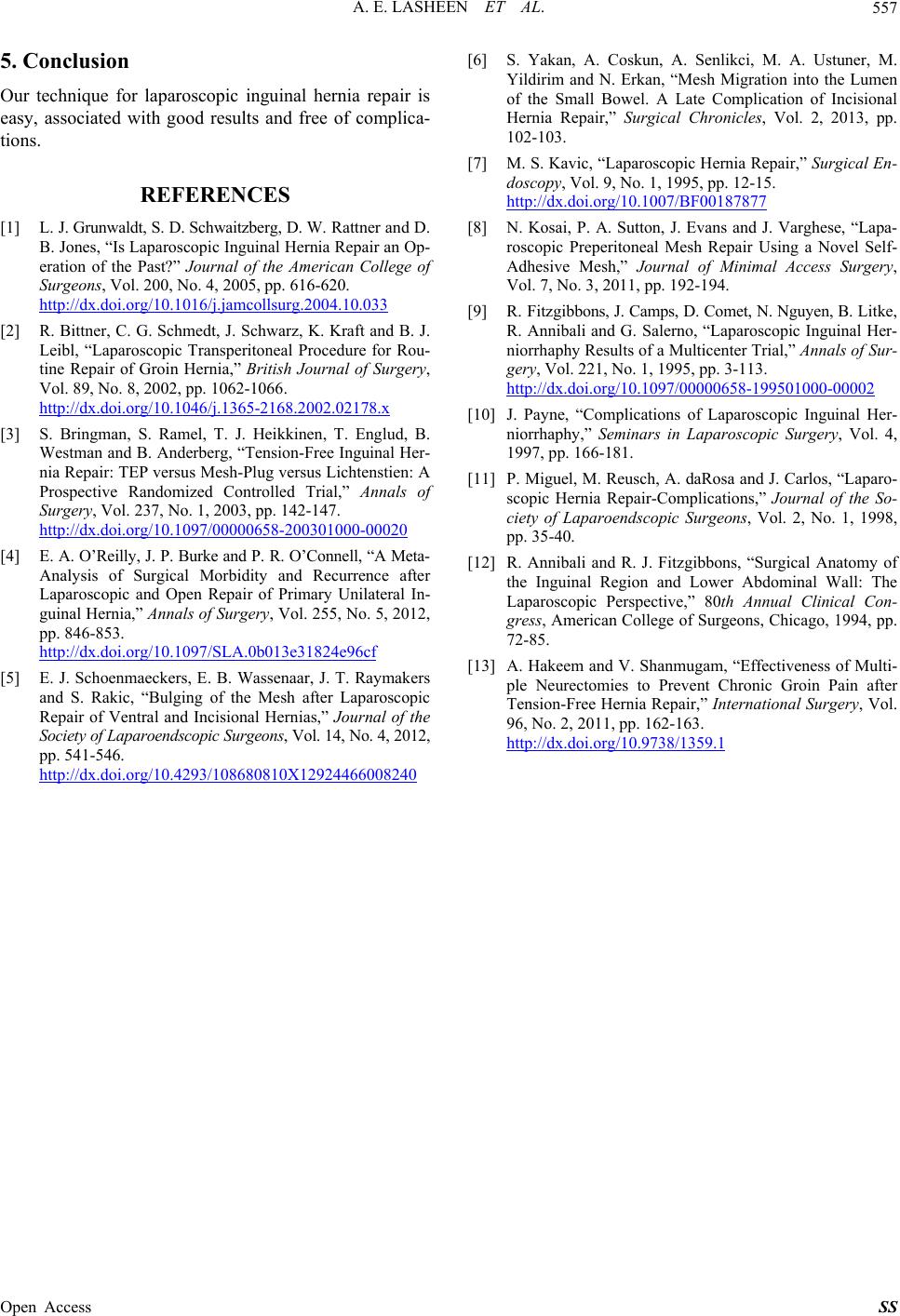
A. E. LASHEEN ET AL. 557
5. Conclusion
Our technique for laparoscopic inguinal hernia repair is
easy, associated with good results and free of complica-
tions.
REFERENCES
[1] L. J. Grunwaldt, S. D. Schwaitzbe rg, D. W. R a tt n e r a n d D .
B. Jones, “Is Laparoscopic Inguinal Hernia Repair an Op-
eration of the Past?” Journal of the American College of
Surgeons, Vol. 200, No. 4, 2005, pp. 616-620.
http://dx.doi.org/10.1016/j.jamcollsurg.2004.10.033
[2] R. Bittner, C. G. Schmedt, J. Schwarz, K. Kraft and B. J.
Leibl, “Laparoscopic Transperitoneal Procedure for Rou-
tine Repair of Groin Hernia,” British Journal of Surgery,
Vol. 89, No. 8, 2002, pp. 1062-1066.
http://dx.doi.org/10.1046/j.1365-2168.2002.02178.x
[3] S. Bringman, S. Ramel, T. J. Heikkinen, T. Englud, B.
Westman and B. Anderberg, “Tension-Free Inguinal Her-
nia Repair: TEP versus Mesh-Plug versus Lichtenstien: A
Prospective Randomized Controlled Trial,” Annals of
Surgery, Vol. 237, No. 1, 2003, pp. 142-147.
http://dx.doi.org/10.1097/00000658-200301000-00020
[4] E. A. O’Reilly , J. P. Burke and P. R. O’Connell, “A Meta-
Analysis of Surgical Morbidity and Recurrence after
Laparoscopic and Open Repair of Primary Unilateral In-
guinal Hernia,” Annals of Surgery, Vol. 255, No. 5, 2012,
pp. 846-853.
http://dx.doi.org/10.1097/SLA.0b013e31824e96cf
[5] E. J. Schoenmaeckers, E. B. Wassenaar, J. T. Raymakers
and S. Rakic, “Bulging of the Mesh after Laparoscopic
Repair of Ventral and Incisional Hernias,” Journal of the
Society of Laparoendsco pic Surgeons, Vol. 14, No. 4, 20 12,
pp. 541-546.
http://dx.doi.org/10.4293/108680810X12924466008240
[6] S. Yakan, A. Coskun, A. Senlikci, M. A. Ustuner, M.
Yildirim and N. Erkan, “Mesh Migration into the Lumen
of the Small Bowel. A Late Complication of Incisional
Hernia Repair,” Surgical Chronicles, Vol. 2, 2013, pp.
102-103.
[7] M. S. Kavic, “La paroscopic Hernia Repair,” Surgical En-
doscopy, Vol. 9, No. 1, 1995, pp. 12-15.
http://dx.doi.org/10.1007/BF00187877
[8] N. Kosai, P. A. Sutton, J. Evans and J. Varghese, “Lapa-
roscopic Preperitoneal Mesh Repair Using a Novel Self-
Adhesive Mesh,” Journal of Minimal Access Surgery,
Vol. 7, No. 3, 2011, pp. 192-194.
[9] R. Fi tzg ibbons, J. Camp s, D. Comet, N. Nguyen, B. Li tke ,
R. Annibali and G. Salerno, “Laparoscopic Inguinal Her-
niorrhaphy Results of a Multicenter Trial,” Annals of Sur-
gery, Vol. 221, No. 1, 1995, pp. 3-113.
http://dx.doi.org/10.1097/00000658-199501000-00002
[10] J. Payne, “Complications of Laparoscopic Inguinal Her-
niorrhaphy,” Seminars in Laparoscopic Surgery, Vol. 4,
1997, pp. 166-181.
[11] P. Miguel, M. Reusch, A. daRosa and J. Carlos, “Laparo-
scopic Hernia Repair-Complications,” Journal of the So-
ciety of Laparoendscopic Surgeons, Vol. 2, No. 1, 1998,
pp. 35-40.
[12] R. Annibali and R. J. Fitzgibbons, “Surgical Anatomy of
the Inguinal Region and Lower Abdominal Wall: The
Laparoscopic Perspective,” 80th Annual Clinical Con-
gress, American College of Surgeons, Chicago, 1994, pp.
72-85.
[13] A. Hakeem and V. Shanmugam, “Effectiveness of Multi-
ple Neurectomies to Prevent Chronic Groin Pain after
Tension-Free Hernia Repair,” International Surgery, Vol.
96, No. 2, 2011, pp. 162-163.
http://dx.doi.org/10.9738/1359.1
Open Access SS